

'I always liked to hear about the old-timers'
Those of you who have followed this column since its inception July 23, 2007, some 380 entries ago according to my quick math, have seen this column evolve into its current format. Originally, it was conceived as a behind-the-scenes look at how National DRAGSTER was produced and a place to talk about what stories we were working on.
It kind of struggled along with a lackluster audience until mid-September of that year, when I got an out-of-the-blue phone call from former U.S. Nationals Top Fuel champ Marvin Graham, who was calling to report the death of his longtime crew chief Chester Garris. As we talked, the reporter in me kicked in, and I asked him about his career, heard some things I'd never heard, hung on every word, and wrote a column about talking with him. The reception was overwhelming, and by word of mouth, the page views of that article shot through the roof.
It was an epiphany for me. I considered myself somewhat of a drag racing history expert – a collective knowledge borne from teenage years of reading magazines and books and watching TV shows and later, of course, firsthand witness – and I realized that so much of what we as fans know about the sport is seared into our brains from multiple accounts that pretty much back up one another. Yet I soon found that there were so many untold tales that needed to be told, subtle nuances that could be layered on the foundation of already-known facts and oft-repeated recounts. So that's where the direction this column went and never looked back.
I began using the tagline "The stories behind the stories" and uncovered fascinating nuances that filled in some of the gaps – it's still happening; for example, in my recent account in National DRAGSTER of the real story behind Jeb Allen's Garlits-busting 5.62 run in Gainesville in 1981 – and was surprised that many of these stories had never been published. Getting the racers to understand that these tidbits of trivial matter might be almost as important as the deeds themselves took some doing and some scratched heads as to why I wanted to know specific details on this or that, but the readers got it. Before long, I was adding the readers' perspective and -- at least at first – unknowingly adding new sentences and paragraphs and even pages to the history book of our sport through the firsthand accounts of those who witnessed these great moments. Longtime Insider reader Mark Watkins, in a very kind post a while ago on Nitromater, likened what goes on here to the new technology of "cloud computing," where all of the assets are out there for all to see and add to.
All of this is a rambling preamble to today's column, another submission from former Funny Car racer Jeff Foulk, who hit me square between the eyes with this comment: "Once us old guys are gone, there will be no one to ask. I dare say there are lots of history buffs who would kill for the chance to talk to a Civil War vet or a witness to the doings of the Wild West. More people (like myself) should keep this in mind and not be stingy with our recollections. There is no substitute for having been there."
That's so true, and as the list of passings continues to grow each year and the oral history is lost, many of us are quietly panicking but also taking action. You might be familiar with Project 1320, which is a dedicated effort by a group that is also racing nature's deadline to accumulate the remembrances of our sport's heroes. It's kind of like losing that great-grandfather in your family, or even your own parents. There's a finite amount of time to probe their memories and ask all of the questions you ever wanted to ask. Don't be afraid to ask, and always be ready to hear.
In a recent issue of National DRAGSTER, I quoted the following line from Tommy Lee Jones' opening monologue in the film No Country for Old Men because it resonated with me: "I always liked to hear about the old-timers. Never missed a chance to do so." Sometimes, like today, it's best just to let the old-timers tell it themselves. Take it away, Jeff …
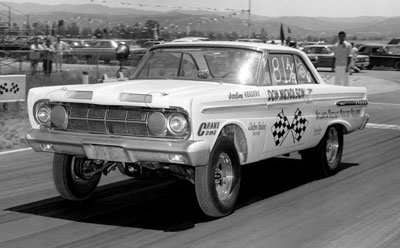 |
"One aspect of the original Funny Car craze that I should have mentioned is exactly how squirrelly the cars really were. You have to remember that they evolved directly from the factory F/X and match race stockers. Once Chrysler took off the gloves with the altered-wheelbase cars, the lid was off the bottle. At first, Ford prohibited their drivers from running match races against the Mopar-backed cars. The Ford drivers took a lot of heat for it but had no choice but comply or lose their sponsorship. Ford knew their A/FX cars were overmatched. The solution soon became apparent: nitro! As I remember it, 'Dyno Don' Nicholson and his stock-bodied Comet were first to make the move. The Mopars soon followed suit. Then, of course, came Ford's reply, with the Logghe-chassised flip-top Comets.
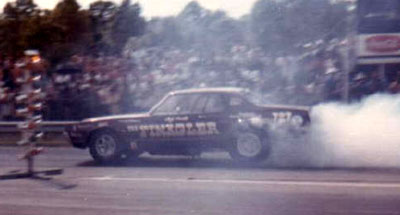 |
"Because the cars had evolved from basically stock-bodied cars with full suspension, the first Funny Cars continued to use the stock suspension systems. We were about making horsepower; suspension and chassis didn't win races. We didn't know; we were making it up on the fly. As a result, loads of power made for some rather dodgy handling characteristics. This was actually a double-edged sword: Although you might be virtually out of control, and literally sideways, you still could drive the car. This made for some really crossed-up runs, which the fans ate up. I can remember leaving the line, going to the edge of the track and back to the centerline, then back to the center, all in low gear! They were a lot more fun to drive than the later cars. It was very frustrating, after many trips into the grass, to realize that I couldn't 'drive' my solid rear car the way I used to my old one. The solid cars were basically point it and pray; once they were crossed up, there was no driving it, no matter how brave or stubborn you were. Then they added guardrails, so you couldn't even venture into the grass. They took all the color out of the game! I think it is an interesting stat to contemplate that today's Hemi Challenge cars were 10.20 cars back in the '60s. Now they run as quick as most of the injected Funnies back in my day. Makes you wonder how our car would have evolved."
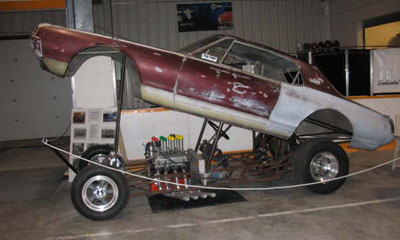 |
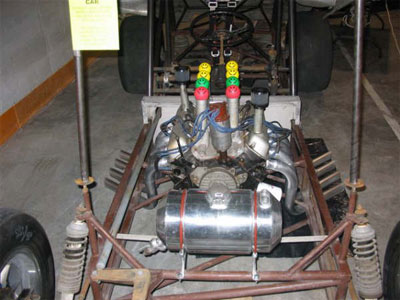 |
Foulk also shared information about the restoration that his original Cougar is undergoing at the hands of Don Sedo.
"My old car will probably be the most authentic restoration in history because it will have the actual, original engine that was actually used in the car on the first go-round," he reported. "This would be quite a stretch for most cases, but for us, it is true. After I retired the Cougar, we had built the GT-40 car with a Boss 351 motor. The old 289 (348), which was pretty tired, was retired and relegated to a corner of the garage. I tried to sell it, but no one serious emerged, so I kept it. It made two brief comebacks, after freshening up, most recently in my crewman Charlie Gilmore's nostalgia dragster. It was in my brother's basement in Pennsylvania when I first came in contact with Don Sedo after he acquired the Cougar. It was picked up and now resides in Canada in its original chassis. The crank, eight rods, six pistons, original oft-repaired heads, and the remaining one of two blocks I had originally built for my Mustang, way back in 1966. Hard to believe, but true. The longevity can be attributed to faithful maintenance, necessity (it was the only engine I had for the Cougar), and the foresight to equip it with a full crank lower end support. I always felt that without the girdle, I would long ago have laid the crank on the ground, especially on a steady diet of 90 percent nitro. It also still has the Hilborn injectors, Vertex mag, and Weiand front cover to mount the fuel pump. Don also has one of two original Fairbanks C-4 transmissions."
As an interesting sidenote and a tale lost to time, our old pal and veteran automotive scribe Rick Voeglin has taken note of Foulk's recent submissions and pointed out that "Jeff didn't mention his shining moment in the pages of Super Stock and Drag Illustrated. An impossibly young Jim McCraw, then SS&DI editor, earned his Experimental Stock NHRA Competition Driver License behind the wheel of the Finagler. Craw's exploits were featured in a five-page article in the February 1969 issue, 'SS&DI Drives a Fuel Funny Car.' He made the required three passes, going 9.91, 138.45 on his final run on 75 percent nitro (good enough for Super Gas these days). There's even a shot of his license signed by Buster Couch. So long before Jon Asher's infamous "I Drove a Funny Car on Fire!" feature, McCraw had already been there and done that (sans flames, fortunately)."
Thanks, Jeff. Interesting info as always. I still have more stuff to share on injected Funny Cars, including a ton of photos you guys have sent, before we move on to other topics. I'm also always interested to get "requests" for what you’d like to read about, sort of an online Readers Choice like we do annually in National DRAGSTER. Let me hear from you (as if I have to ask).

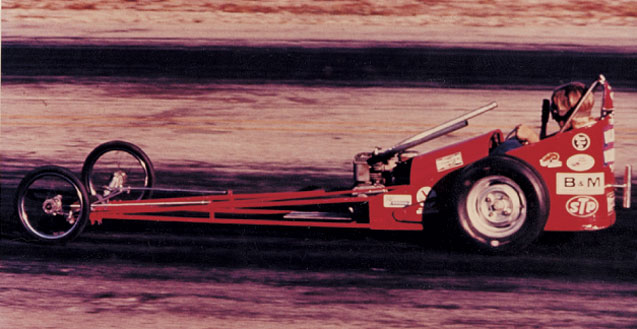 |
Speaking of restorations and getting back old cars, I got an e-mail this week from Darrell Gwynn, who's looking for his first dragster, which may well have been one of the sport's first "Jr. Dragsters." That's it above.
Darrell's dad, Jerry, built the car out of electrical conduit in 1967. At the time, it had a four-horsepower Briggs & Stratton engine and was belt-driven. Darrell said that he believes the wheels were from a Karmann Ghia.
"I am trying to get my hands on that car," he wrote. "I sold that car for $200 to buy a motorcycle; pretty stupid, huh? I am really hopeful that it is out there and that your readers can help."



















































